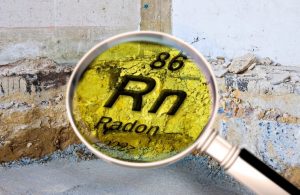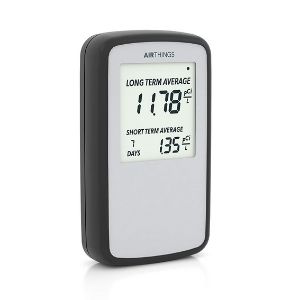Best Radon Detectors for Your Home
*Amazon.com price as of 04/08/2021 at 10:06 a.m. (MT). Read full disclaimer.
In years past, radon tests required lab fees, postage, and a lot of waiting (which is tough with something as dangerous as radon). That’s why we chose smart radon detectors like the Radon Eye RD200, AirThings Wave, and AirThings Corentium for our top spots.
These radon detectors conduct long-term tests and instant readings of radon concentration in your home. The Radon Eye RD200 provides a quick reading within 10 minutes of setup and a more accurate reading after 1 hour—pretty fast considering the 72-hour wait for lab results.
Best radon detectors

The highest concentrations of radon can be found below-ground levels without much ventilation such as basements, crawlspaces, foundations, sump pumps, and construction joints. There are pockets of radon across the country, but some states have higher levels than others.
Compare the best radon detectors
*Amazon.com prices as of 04/08/2021 10:06 a.m. MST. See full disclaimer.
1. Radon Eye RD200: Best overall
The Radon Eye RD200 tops our list for its fast, accurate readings. After setting up this radon detector, you’ll get your initial reading within the first 10 minutes with a more accurate reading appearing within the next 60. While that might sound like a long wait, many lab tests and other digital radon detectors can take several days to produce an accurate reading.
This radon detector may seem expensive at first glance, but it comes with some serious credibility. The ion chamber within the RD200 was validated by the Department of Nuclear Engineering and Radiological Science at the University of Michigan.
The RD200 is a continuous radon monitor that checks the air 30 times per hour and updates its readings every 10 minutes. You can check the radon concentration in your home on the device’s digital screen or the device’s app.
If levels reach dangerous heights, you’ll be alerted by the RD200’s alarm or within the app. We recommend giving this detector and others plenty of time to read the air in your home before acting quickly. The longer you leave a radon detector out, the more accurate the readings generally become.
If you’ve moved to a new home in an area with high radon concentration, this is an investment worth making. With its detailed readings and easy setup, the initial $200 for this radon detector is well worth the money.
2. AirThings Wave: Best smart radon detector
The AirThings Wave is a subtle tea saucer-sized radon detector with a lot of smarts inside. It runs on good old-fashioned batteries but uses Bluetooth to connect to the AirThings app and other devices you may have in your home like your Amazon Echo or Google Assistant.
While it doesn’t have a digital display, you can check levels with a simple hand motion and a glance. The ring light around the radon detector will glow green, yellow, or red to indicate levels. You can get exact readings on the app if you want to get more specific.
Part of what makes this radon detector so smart is its ability to connect to other devices. If you have a smart speaker like an Amazon Echo or Google Nest Hub, you can check the levels without picking up your phone or running to the basement. The Wave also works with IFTTT automation. For example, have your smart bulbs flash or change colors if radon concentration rises to dangerous levels.
In the past, radon detectors weren’t the sexiest devices in your home. But the AirThings Wave combines smart features with beautiful design to keep your family safe from the ground up.
3.AirThings Corentium: Best digital test
The Corentium Home Radar Detector by AirThings looks like a vintage cell phone and runs a little under $200. But, with that cash, you get a portable device that provides long and short-term readings for radon concentration.
Because it’s battery-operated and so small, you can place it anywhere in the house for a quick reading or compare levels throughout your property.
The AirThings Corentium even works in dusty and humid conditions like your crawl space or basement (where radon tends to collect the most). Because you get your readings instantly, you won’t need to pay for lab fees or postage stamps to send it off.
However, this radon detector isn’t as fast with its readings as our top two choices. The specifications say you get the best results after 24 hours of the detector sitting in place. But this isn’t uncommon in devices like it. Overall, we recommend giving any detector you use plenty of time to get the most accurate reading.
4. SafetySiren Pro4: Best for long- and short-term tests
The SafetySiren Pro4 Radon Detector costs more than most on our list, but it has the features to justify the price. Instead of a one-time monitoring sample, the SafetySiren takes air samples continuously and displays the new results every hour on a backlit LCD screen.
It’s also EPA-evaluated, meaning it meets federal standards for radon detectors and can last up to five years.
5. First Alert RD1 Radon Gas Test Kit: Quick test pick
First Alert offers an easy setup and fast analysis. The company delivers test results, along with a detailed action plan, within 72 hours of receiving your radon sample. This is a great kit for home buyers, as the kit only needs 48 hours to test radon levels.
First Alert claims a spot on the EPA Radon Gas Measurement Proficiency Program.
You are responsible for the return postage costs, and the price does not include the lab fee costs for New Jersey residents.
Where to put a radon detector
The detector placement and length of the test depend on the type of radon detector you choose. For the best results, be sure to read the instructions carefully.
Radon is a radioactive gas produced by decaying elements underground.1 It enters your home through cracks in the foundation and walls in areas like your basement. So it’s best to place your radon test kit or radon detector at the lowest level of your home.
- If testing short-term radon concentration, be sure to close all doors and windows before and during the test.
- Avoid humid areas like your bathroom or laundry room to avoid malfunctions.
- Crawlspaces, construction joists, and sump pumps can create false positives or incorrectly high results.
- Document the test by writing down the start date and time of the test, especially if the test takes over 72 hours.
- Follow all instructions for the radon detector or radon test for the most accurate results.
Types of radon detectors
Some areas are more vulnerable to radon than others. This EPA map shows the highest levels in northern states like Montana, North Dakota, Wyoming, and Iowa.
If you live in or are moving to one of these areas, start with an inexpensive short-term test. Depending on your findings, you can invest in a full radon detector to monitor levels.
Radon test kits
A short-term radon test kit gives you a snapshot of your home’s levels during a period of time. These kits are designed to sit in an area like your basement for anywhere between 48 hours. Generally, the longer the test takes, the more accurate the results.
The charcoal inside the tests absorbs the radon particles. Once the test is finished, you’ll send off the testing kit to a lab where technicians will analyze the sample and provide you with results.
If you’re worried about radon, these test kits are the best way to get started. If you find high levels of radon in your home after testing, that’s when you should invest in a radon detector.
Radon detectors
If you’re looking for a more reliable overall picture of your home’s radon level, a long-term test kit is a good choice.
These detectors use alpha track detection or ionization chambers to measure the radon gas in the air over a period of time. Even detectors like the Radon Eye RD200 need longer amounts of time to get the best results.
These detectors work like smoke alarms and carbon monoxide detectors to measure the amount of radon in the air and alert you when it reaches dangerous levels.
Because radon detectors are so expensive, they’re a better investment for folks who live in radon-rich areas. That said, radon levels fluctuate throughout the year and can vary from house to house, so it never hurts to add it to your arsenal of home safety equipment.
If you have detected high levels of radon in your home, you should hire a contractor who specializes in radon mitigation. You can search for contractors and see user reviews on Thumbtack.
Final word
Whether you’re concerned about radon levels in your basement, crawl space, or regular living areas, the Radon Eye RD200 is the best long-term solution.
It’s pricier than the rest on our list, but its readable LCD screen, frequent display updates, and app access make this detector worth it.
How we reviewed radon detectors
Before reviewing radon detectors, we learned the science behind this radioactive gas, how it affects humans, how it gets into homes, and how radon tests and detectors work. All the videos, articles, and digging gave us a better understanding of what makes a quality radon detector or radon test.
After we got the science down, we compared different tests and detectors side by side based on factors like waiting time for the first reading, alert modes, and displays.
See how we apply our own scientific method in reviews like this and more from the Safewise methodology page.
FAQ
Radon detectors measure levels in picocuries per liter (pCi/L) to indicate the average, year-round radon levels. If your home measures between 2 pCi/L and 4 pCi/L, consider taking steps to reduce radon levels.
Any result above 4pCi/L should be confirmed with a follow-up test. If the result remains high, take immediate action to reduce the radon levels in your home.
Radon is a byproduct of uranium, which is found naturally in soil. As uranium decays, it releases radioactive particles of radon called radon daughters (or alpha particles), which can then seep in through tiny cracks in your foundation or walls and into your air.
Radon isn’t picky about where it shows up. Any building—a home, school, office, store, or warehouse—is susceptible to radon contamination.
Place your radon detector in the lowest level of your home in an area without ventilation or airflow. Follow the test’s setup instructions, then leave the area undisturbed until the test is done. Remember, the longer you leave the test out, the better results you’ll have.
Your radon detector is designed to find out how much radon you’re being exposed to on a daily basis, so keep it nearest the lowest level areas where you and your family spend the most time.
Once you know your levels are higher than the recommended amount, your first step is to find a contractor qualified in radon mitigation. Contact your state radon office for a list of contractors in your area. You can also search for a qualified radon mitigation contractor on Thumbtack. Once you select a contractor, they will usually begin by sealing any cracks or crevices in your foundation. Then, they’ll install a mitigation ventilation system to help air better circulate and reduce the risk of radon inside your home.
Because few cases of radon contamination are the same, each one will have a different price tag. But on average, you can expect to pay at least $500 for basic mitigation services, and possibly more if you have a trickier situation.
The National Cancer Institute cites radon as a leading cause of lung cancer, second only to cigarette smoke, causing somewhere between 15,000 and 22,000 lung cancer deaths annually.2 Anyone who smokes and is also around higher radon levels are at an elevated risk of developing lung cancer.
Keep in mind that not everyone who is exposed to high levels of radon will get lung cancer. According to the EPA, only about 4% of nonsmokers will get lung cancer from radon exposure, even from greatly elevated levels of the gas.
Related pages on SafeWise
Sources
- Environmental Protection Agency, “What is radon gas? Is it dangerous?” Accessed April 8, 2021.
- National Cancer Institute, “Radon and Cancer,” Reviewed December 6, 2011. Accessed April 8, 2021.
Disclaimer
*Amazon.com list price as of 04/08/21 10:06 a.m. MST. Product prices and availability are accurate as of this date/time indicated and are subject to change. Any prices and availability information displayed on Amazon at the time of purchase will apply to the purchase of this product. Safewise.com utilizes paid Amazon links.
Certain content that appears on this site comes from Amazon. This content is provided “as is” and is subject to change or removal at any time.
The post Best Radon Detectors for Your Home appeared first on SafeWise.
Article source here: Best Radon Detectors for Your Home



No comments:
Post a Comment